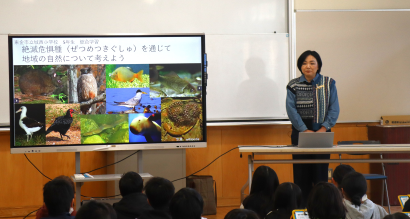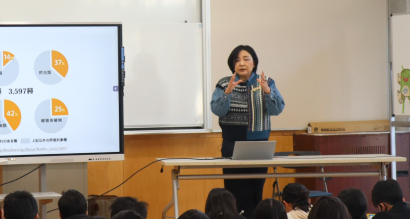JIU Josai International University

Professor Kunitake from Faculty of Management and Information Sciences becomes an environmental studies teacher at an elementary school in Togane City
Regional cooperation
2025.02.28

Professor Kunitake greeting the students
On February 25th, Professor Yoko Kunitake from Faculty of Management and Information Sciences gave a class to 52 fifth graders at Togane City Josai Elementary School on the theme of "Let's think about the local nature through endangered species." Josai Elementary School students learn about the environment as part of their comprehensive studies class. This is the third time this year that Professor Kunitake has taught this class. She continues to work to convey an understanding of the environment and living things in the local area to students.
In the first half of the lesson, we explained the meaning of extinction of living things. Using the Japanese wolf, which became extinct in 1905, as a representative example, we explained the current state of Japan's ecosystem. We asked questions and listened to the students' thoughts as we proceeded with the lesson. The students answered the questions seriously, thinking about whether extinction only has negative aspects, and what would happen if the ecosystem were to collapse.

In the second half, the importance of the rich Satoyama that remains in the region was conveyed using the Sanmu region as an example. The Sanmu region is located in an area where three environments, the Shimousa Plateau, the Kujukuri Plain, and the Boso Hills, are adjacent to each other. It was also explained that the Sanmu region is a precious place where the "Satoyama" environment, where many of Japan's endangered species live, remains.
Professor Kunitake is Research the local ecosystem, including the Tokyo salamander. There is a place near Josai Elementary School where the precious Tokyo salamander lives, and last year the fifth graders carried out conservation activities to maintain the waterway. However, this year water has stopped flowing into the waterway, and the salamanders no longer have a place to lay their eggs. Using a map showing the Tokyo salamander's spawning grounds in the Sanbu region, he explained to the students the current situation in which changes are occurring at an extraordinary speed even in familiar places.
Professor Kunitake told the students, "In terms of the evolution of living things, the prosperity of some species may be possible only after other species have gone extinct. We also need to think about the present from past events, such as the circumstances that led to the extinction of living things in the past and their impacts," conveying his thoughts on the environment. This year, there will be two lessons, including this one, and the next one will be on March 11th, when the students will give a presentation together with Professor Kunitake on what they have learned from today's lesson.
After the lesson, the children said, "Thank you for the lesson today. I want to reexamine my lifestyle and think about what I can do," and talked about how they had become more aware of the environment.